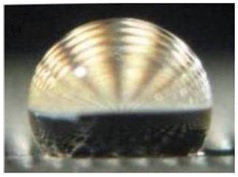 One of the most common water repellant surfaces, which all of us would
have seen and admired, is the waxy surface of a lotus leaf. Water
droplets glide on the plant’s leaves without wetting them. Called “The
Lotus effect”, the phenomenon has fascinated scientists for some time.
If we cover the hull of a boat with lotus leaf, will the boat also
glide on the water? Anyone who has observed the lotus leaf carefully
would know that the leaf loses its property even if it is kept immersed
for few minutes.
One of the most common water repellant surfaces, which all of us would
have seen and admired, is the waxy surface of a lotus leaf. Water
droplets glide on the plant’s leaves without wetting them. Called “The
Lotus effect”, the phenomenon has fascinated scientists for some time.
If we cover the hull of a boat with lotus leaf, will the boat also
glide on the water? Anyone who has observed the lotus leaf carefully
would know that the leaf loses its property even if it is kept immersed
for few minutes.A team of researchers at the Indian Institute of Science has now created an artificial surface that retains its water repelling properties -- under water -- for a long time. They are also able to control the time for which water repelling properties are retained, which may result in diverse applications like better printers, and efficient and cheap blood testing.
Such materials work because they have special structures on their surface that trap tiny pockets of air. These tiny air pockets allow water to flow without coming in contact with the surface, and thus flow with reduced resistance. However, if the surface stays in contact with water for long time, the air dissolves in water, just like in the immersed lotus leaf; the effect vanishes.
 Prof Bobji and his team have discovered
a novel way to control the time for which the air pockets can stay
“alive” longer. They exploit the fact that the solubility of air in
water depends on pressure. At low pressure, water cannot dissolve gases
easily; this is why the soft drink bottles are pressurised, it keeps
the carbon dioxide dissolved.
Prof Bobji and his team have discovered
a novel way to control the time for which the air pockets can stay
“alive” longer. They exploit the fact that the solubility of air in
water depends on pressure. At low pressure, water cannot dissolve gases
easily; this is why the soft drink bottles are pressurised, it keeps
the carbon dioxide dissolved.In fact, the team has shown that by lowering the pressure, they can even supply air to these pockets, thus prolonging the effect further. They are also able to manipulate how fast these air pockets grow by controlling the flow rate.
Until now, it was only very tiny air pockets (one hundredth of a millimetre) that could be sustained for long periods of time, which limited their application. Prof. Bobji, who led the team, says "What we have demonstrated is that even bubbles of 0.3 mm can be sustained for longer than 5 hours easily with our "air-pump" methodology, resulting in drag reduction of up to 20%."
Efforts are now underway to create large surfaces with similar properties. If successful, we can even hope to see submarines that travel with little effort one day.